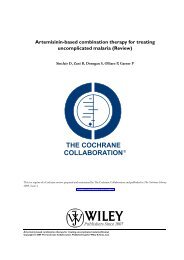Antiamoebic drugs for treating amoebic colitis - The Cochrane Library
Antiamoebic drugs for treating amoebic colitis - The Cochrane Library
Antiamoebic drugs for treating amoebic colitis - The Cochrane Library
You also want an ePaper? Increase the reach of your titles
YUMPU automatically turns print PDFs into web optimized ePapers that Google loves.
Figure 3. Combination regimen vs monotherapy: parasitological failure 1 to 14 days after end of treatment,<br />
subgrouped by intervention.<br />
For both clinical and parasitological failure, sensitivity analysis<br />
was not possible because none of the trials were adequately concealed<br />
and only Prasad 1985 was double-blind. <strong>The</strong> overall results<br />
<strong>for</strong> both outcomes were driven by one trial (Asrani 1995) that analysed<br />
a large number of participants (896 participants analysed <strong>for</strong><br />
clinical failure; 591 participants analysed <strong>for</strong> parasitological failure)<br />
compared to the other two trials. This trial was an open label<br />
trial with unclear allocation concealment and method of randomization,<br />
hence the high possibility of bias. A sensitivity analysis<br />
per<strong>for</strong>med by excluding this trial significantly changed the overall<br />
results <strong>for</strong> both outcomes such that no difference between combination<br />
therapy and metronidazole alone was seen (RR 0.58, 95%<br />
CI 0.20 to 1.73; 129 participants, 2 trials, analysis not shown).<br />
<strong>The</strong> change in the overall result weakens the strength of the evidence<br />
<strong>for</strong> the advantage of combination therapy over metronidazole<br />
alone.<br />
No data on relapse were reported.<br />
Only one trial reported details <strong>for</strong> adverse events (Asrani 1995).<br />
One participant given a fixed-drug combination tablet of metronidazole<br />
and diiodohydroxyquinoline developed an unspecified allergic<br />
reaction on the first day necessitating withdrawal from the<br />
trial (see Appendix 13 <strong>for</strong> details).<br />
3.2. Combination regimen versus other single drug regimens<br />
Four trials made this comparison. Two trials compared combination<br />
regimen with other nitroimidazoles: a combination of tetracycline<br />
and clioquinol with secnidazole alone (80 participants, 1<br />
trial); and a combination of tinidazole and diloxanide furoate with<br />
tinidazole alone (41 participants, 1 trial). <strong>The</strong> third trial compared<br />
three different combinations (nimorazole and aminosidine,<br />
<strong>Anti<strong>amoebic</strong></strong> <strong>drugs</strong> <strong>for</strong> <strong>treating</strong> <strong>amoebic</strong> <strong>colitis</strong> (Review)<br />
Copyright © 2009 <strong>The</strong> <strong>Cochrane</strong> Collaboration. Published by John Wiley & Sons, Ltd.<br />
nimorazole and etophamide, and etophamide and aminosidine)<br />
with the same <strong>drugs</strong> given as monotherapy (400 participants, 1<br />
trial). <strong>The</strong> fourth trial compared quinfamide and mebendazole<br />
with nitazoxanide (80 participants, 1 trial).<br />
<strong>The</strong> trials could not be pooled because of different drug comparisons,<br />
but the data <strong>for</strong> clinical failure (Analysis 3.1) and parasitological<br />
failure (Analysis 3.2) are presented. <strong>The</strong> trials did not show<br />
any difference in clinical or parasitological failure rates between<br />
combination regimens and single drug regimens, except <strong>for</strong> two<br />
comparisons. One trial showed that secnidazole alone resulted in<br />
greater resolution of clinical symptoms and greater eradication of<br />
E. histolytica compared to the combination of tetracycline and clioquinol<br />
(80 participants, Soedin 1985, Analysis 3.1. and Analysis<br />
3.2). Another trial showed that the combination of tinidazole and<br />
diloxanide furoate resulted in greater eradication of E. histolytica<br />
compared with tinidazole alone (41 participants, Pehrson 1984).<br />
No data on relapse were reported.<br />
None of the trials reported on serious adverse events. Recruitment<br />
of participants in the combination etophamide-aminosidine group<br />
was discontinued because of the high incidence of severe diarrhoea.<br />
No further details <strong>for</strong> adverse events were reported in the other<br />
trials.<br />
4. Single-dose regimen versus longer regimen<br />
Five trials compared a single-dose regimen with a multiple-dose<br />
regimen or longer durations of therapy.<br />
15








